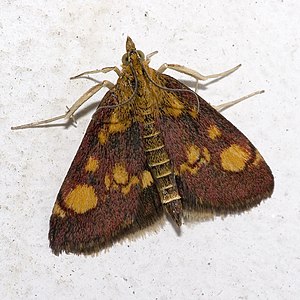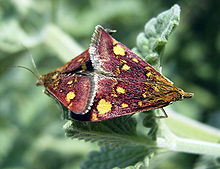Gold borer
| Gold borer | ||||||||||||
|---|---|---|---|---|---|---|---|---|---|---|---|---|

Golden borer ( Pyrausta aurata ) |
||||||||||||
| Systematics | ||||||||||||
|
||||||||||||
| Scientific name | ||||||||||||
| Pyrausta aurata | ||||||||||||
| ( Scopoli , 1763) |
The mint moth ( Pyrausta aurata ), also mint moth called, is a butterfly from the family of Crambidae . The species is often to be found in the literature under the name of purple-headed ; however, this name is occasionally used for the purple borer ( Pyrausta purpuralis ). This species is also very similar and is often confused with the gold borer.
features
The moths of the golden borer reach a wingspan of about 18 to 20 millimeters (or a forewing length of 8 to 9 mm). The forewings are purple-red to red-brown in basic color with a few yellow spots. The number and intensity of the spots is variable or almost completely absent. Around the middle of the wing there is a more or less clearly developed, darkly drawn transverse line to the rear edge. This is wavy to jagged and ends roughly in the middle of the inner edge (or also the rear edge) of the forewing. The yellow spots, if present at all, can be located at the root or along the edge of the transverse line.
The hind wings are dark brown to black with a broad yellow transverse band around the middle of the wing.
The egg is elongated and greenish-yellow in color.
The caterpillar is light green, dark green, light brown, black gray or reddish in color and shows a darker back line. The head and the neck plate are brownish black. It grows up to 13 mm long.
The slender pupa is red-brown to black-brown.
Similar species
The species is difficult to distinguish from the purple borer ( Pyrausta purpuralis ), and Pyrausta ostrinalis can sometimes be very similar.
- In Pyrausta purpuralis , the transverse line forms a wide, basal curve towards the rear edge. The ever-present yellow spot on the rear edge lies towards the hem and is usually crescent-shaped. The stain often frays towards the edge and can form several points. But it can also be cut straight. The transverse line ends at the rear edge approximately in the middle of the rear edge. The arch of the transverse line is somewhat steeper than in Pyrausta ostrinalis , the yellow spot is therefore somewhat more compact ("third" or "half moon").
- Pyrausta aurata has a wavy to serrated line as a transverse line. The yellow spots are distributed on both sides of the transverse line. The yellow spots can also be greatly reduced or even completely absent. The transverse line ends at the rear edge towards the center of the rear edge.
- In Pyrausta ostrinalis , the yellow spots are in the form of a more or continuous transverse band. The dark transverse line cuts this ribbon in a wide, flat arc. The rear yellow spot is therefore mostly oblong ("quarter moon").
Geographical distribution and habitat
The species is widespread in Europe, North Africa and North Asia. In the east, the distribution area extends across Siberia to the Russian Far East, northern China, Korea and Japan. In the south, it extends through Asia Minor, the Middle East, Iran, Afghanistan, Central Asia, and Mongolia.
Their habitat includes dry and moist meadows, pastures and grassy areas on streams, paths and forest edges and in gardens.
Way of life
The gold borer forms two generations per year in Central Europe; the moths fly from May to June and from July to August. The moths are diurnal and nocturnal. The food plants of the caterpillar include mint ( Mentha ), thyme ( Thymus ), oregano ( Origanum vulgare ), meadow sage ( Salvia pratensis ), lemon balm ( Melissa officinalis ), catnip ( Nepeta cataria ) and mountain mint ( Calamintha ). The caterpillars live gregariously in webs made of woven leaves or flowers of the food plants. At first there is window corrosion, later mostly edge or pitting corrosion, the flowers are also eaten. The caterpillars are found from June to July and then again from September. The pupation of the summer generation takes place in a web. The second generation caterpillars overwinter and pupate in a cocoon on the ground in spring.
Systematics and taxonomy
The taxon was first scientifically described in 1763 by Giovanni Antonio Scopoli (in this publication Ioannes Antonius Scopoli) as Phalaena aurata . The type locality is in "Carniola" ( Carniola , today Slovenia); the holotype is lost.
swell
Individual evidence
- ↑ a b Küppers (2008: p. 370)
- ↑ a b c d Hannemann (1964: p. 360, 362)
- ↑ Photo of the eggs ( Memento of the original from December 14, 2011 in the Internet Archive ) Info: The archive link was inserted automatically and has not yet been checked. Please check the original and archive link according to the instructions and then remove this notice. UK moths - website by Ian Kimber
- ↑ a b c Peter Buchner: Differences between Pyrausta aurata and Pyrausta purpuralis - Lepiforum
- ↑ Geoffrey Abbott, Peter Holden: RSPB Handbook of Garden Wildlife. Christopher Helm, London 2008, ISBN 978-0-7136-8860-3 , 240 p. GoogleBooks
- ↑ Hiroshi Inoue: Check list of the Lepidoptera of Japan. Part 2. Rikusuisha, 1954
- ^ Hassan Mohammadian: Biological diversity of Lepidoptera in Iran: geographic distribution of 2200 species. Shabpareh Publications, Tehran 2006, ISBN 964-96358-4-X , 386 pp.
- ↑ Ayuna A. Shodotova: Pyralid Moths (Lepidoptera, Pyraloidea) of Buryatia: Family Pyraustidae. Entomological Review, 88 (5): 543-557, 2008 DOI: 10.1134 / S0013873808050035
- ↑ Slamka (1997: 22)
- ↑ Joannes Antonius Scopoli: Entomologia Carniolica: exhibens insecta Carnioliae indigena et distributa in ordines, genera, species, varietates: methodo linnaeana . Johannes Thomas Trattner, Vienna 1763, 420 p. Biodiversitylibrary.org (description p. 227)
literature
- Hans-Joachim Hannemann: Small butterflies or Microlepidoptera II. The moths (sl) (Cochylidae and Carposinidae) The moths (Pyraloidea). In: Friedrich Dahl: The animal world of Germany and the adjacent parts of the sea according to their characteristics and their way of life. Part 50., VEB Gustav Fischer Verlag, Jena 1964
- Peter V. Küppers: Small butterflies - recognize and determine. Fauna-Verlag, Nottuln 2008, ISBN 978-3-935980-24-1 , 399 pp.
- František Slamka: The common moth (Pyraloidea) of Central Europe: determination - distribution - flight area - way of life of the caterpillars . 2nd partially revised edition, Bratislava 1997, ISBN 80-967540-2-5
Web links
- lepiforum.de taxonomy and photos
- Moths and Butterflies of Europe and North Africa (English)
- hlasek.com (English)
- Ian Kimber UK Moths (English)
- Pyrausta aurata at Fauna Europaea
- GlobIZ
- euroleps.ch Website by Heiner Ziegler
